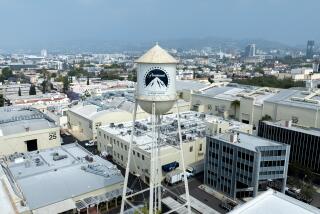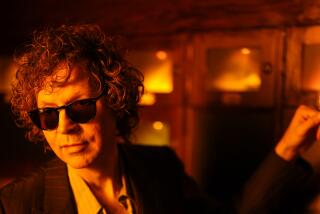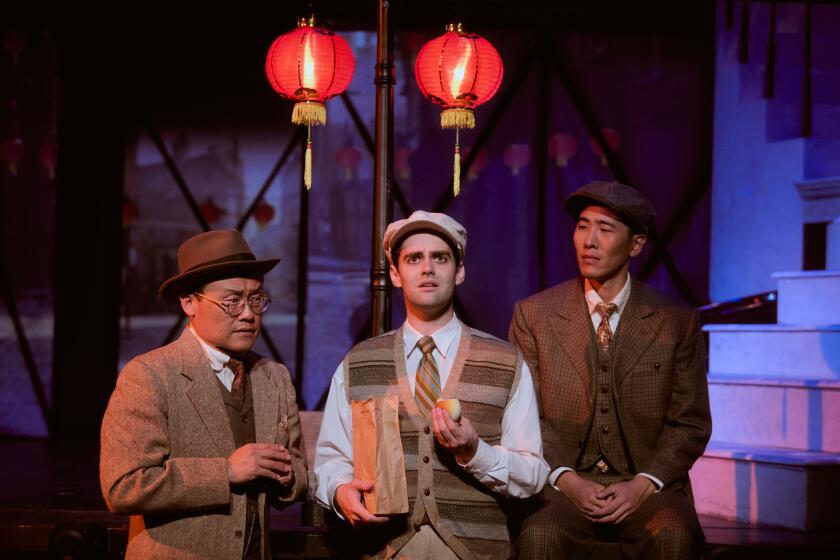With a Little Bit of Pluck
A sense of renewal pervades Lou Harrison’s house, a rambling, slightly funky compound high on a hill in this modest beach town a few miles south of Santa Cruz.
There is, first of all, the revival of Harrison’s music. Harrison turns 80 on May 17, and, after years of obscurity, the world is finally beating a path up this high hill.
But Harrison, dressed in his trademark oversized red corduroy shirt, comes to the door fresh from a different kind of revival. There has been a small crisis, he immediately explains. Fond of crickets, Harrison says that one got trapped in a bowl and appeared to be lifeless. Not about to give up on it, the composer thought some slices of cheese and apple might revive the small critter. It did.
And then there’s Harrison’s companion of 30 years, William Colvig, an irrepressible outdoorsman and instrument builder who is also about to turn 80 and who is recuperating from a knee replacement surgery.
“Bill’s got a new prosthetic,” Harrison says, “I saw it through the X-ray, and it looks beautiful. Just like a Brancusi. Not only is Bill no longer bowlegged but he is now taller.”
Harrison sits on the sofa, eager to talk. He, too, has grown much taller--in the public eye and the music world. For instance, although he is not in the habit of writing for superstars, he has just finished a piece for cellist Yo-Yo Ma commissioned by choreographer Mark Morris for a work that will premiere at the University of California at Berkeley.
“I did some risky things for Yo-Yo in the first music that I sent him and there was no problem. So from there on I just thought, well, here we go!”
The Morris commission, which will also be part of an all-Harrison program the choreographer will present at the Brooklyn Academy of Music in May titled “The Divine Mr. Harrison,” is only the tip of the birthday year iceberg. The Bay Area is throwing no less than three Harrison festivals, and New York, where Harrison has long been dismissed as too West Coast, has three as well. Vienna has something planned, and last summer Harrison received the rare accolade of a New Yorker profile. (In Southern California, the only acknowledgment so far scheduled is the inclusion of some Harrison works in an evening of microtonal music at Pierce College in Woodland Hills on Saturday.)
“It should have happened when I was a kid,” Harrison says, throwing his arms up in mock horror and laughing hard. “Remember, I’m now an old man, and crotchety. But there is no use being old if you’re not crotchety.” More delighted laughter.
There is no escaping that Harrison is getting old. Writing music--putting dots on paper, as he says--now physically hurts his hands, but he is doing more of it than ever. He has a long, snowy white beard and long, snowy white hair, tied in a ponytail. San Francisco Symphony Music Director Michael Tilson Thomas calls him new music’s Santa Claus.
Harrison both looks the part and exhibits certain Santa-like qualities. He’s got Santa’s size, and his big, happy laugh. In a favorite phrase, he describes his inordinately wide range of interests and activities, musical and otherwise: “From the start, I spread my toys out on a large acreage.”
That spreading began long ago, in the ‘30s, and as the world begins to catch up with him, it also makes him seem a sage. He began mastering musical techniques of China, Korea, Japan and Java long before world music became a popular genre. He involved himself in the instruments and performing practice of Renaissance and Baroque music in his college days, decades before there was an early-music movement. He was in on the ‘30s percussion wave from its beginnings, and he was among the first composers to use found objects as instruments.
In his own work, over 300 pieces, there seems not to be a style he hasn’t tried. He’s made 12-tone symphonies, modernist percussion pieces, Baroque harpsichord sonatas. He retunes instruments, as he did for both piano and orchestra in the piano concerto he wrote for Keith Jarrett in 1985. But mostly he is associated with finding ways to bring something of the music of Asia into a Western context, especially the mellow sound of the bells and gongs that make up the Indonesian gamelan.
That all these various cultures and styles and music can be comfortable with one another has become central to Harrison’s life and work.
“Hybrids are everything,” he is fond of saying. “Where would nature be without them?
“An idea I think our culture got from Europe,” he says, “is that you have to destroy before you can build something good. Well, I don’t believe that. I’m with the Japanese who say, no, put it just beside. Keep the old. Put the new along with it. Try everything is my idea. What’s more, have fun with it.”
Harrison--who was born in Portland, Ore., but grew up in Northern California--is very much the product of a West Coast sensibility. His mother, Calline Lillian Silver Harrison, loved cars (she was the first woman to drive across the Steel Bridge to Portland) and Asian art, and she believed that Harrison should have a broad education that included a study of all the religions so that he could make his own choice. His father, Clarence Harrison, sold automobile tires during the day and read James Joyce to the family at night.
Just as remarkable was Harrison’s musical education. He enrolled at San Francisco State College in 1934, where he studied clarinet, harpsichord, French horn and recorder. He “sang, sang, sang” in choirs and madrigal groups. “I still know the bass parts of all the madrigals,” he says. He dabbled in dance, as performer, choreographer and composer. And, most important, he fell under the spell of the prototypal California composer Henry Cowell.
Cowell, who invented tone clusters--groups of notes played with fist and forearm on the piano--and playing directly on the strings inside the piano, took inspiration from all the ethnic cultures he encountered in San Francisco. Studying with Cowell at the University of California extension and privately, Harrison soon became part of the composer’s circle.
“He went the whole gamut,” Harrison says in explaining the kind of example Cowell presented for him in the ‘30s. “Of course, I extracted as much as I could from poor Henry. I was always extracting, and I must have been a terrible pest.”
Cowell eventually sent Harrison to Los Angeles to study with Arnold Schoenberg, the great German composer who invented the 12-tone system. But Harrison delights in recounting that it was “Cowell who taught me how to write 12-tone music, while Schoenberg liked my neoclassical pieces.”
In the mid-’40s, Harrison moved East and plunged into the musical maelstrom. He served as a junior music critic under Virgil Thomson at the New York Herald Tribune, composed, edited Charles Ives’ manuscripts, conducted the premiere of Ives’ Pulitzer Prize-winning Third Symphony, and socialized--heavily--with John Cage and the rest of the avant-garde set.
It all landed Harrison in the hospital for eight months with a nervous breakdown. After a period of recuperation teaching at the legendary experimental Black Mountain College in North Carolina, Harrison returned to California in 1954, where his parents bought him the house on the Aptos hill.
From his perspective now, his retreat from New York City has never been a hardship: “You know, the mails still work, so does the telephone. And, of course now the fax machines work,” he says.
But the move did take a toll. Until the arrival of Tilson Thomas as music director in 1995, the 85-year-old San Francisco Symphony--looking more to the East Coast and Europe for validation instead of to local composers--never included his works in their subscription programs. Outside of San Francisco, Harrison was hardly known at all except in New Music circles.
Over the years, to make ends meet, Harrison took on a variety of jobs, including work in an animal shelter. In the late ‘60s, he began a long stint in academia, teaching world music for 17 years at San Jose State and then for a decade at Mills College in Oakland.
The conventional theory is that if Harrison could have stuck it out in New York, he would have caught on, becoming a central rather than peripheral figure in American music. Before he left town, such New York City luminaries as Aaron Copland and conductor Leopold Stokowski, in addition to Thomson, his boss at the Herald, were in his corner.
But in New York Harrison would never have become the composer he did. He simply couldn’t work amid the chaos, he says, exhibiting amazement that anyone can. More important, the return to California reinforced Harrison’s allegiance to the West, encouraging him to look to Asia rather Europe for his inspiration. It was on a trip to Indonesia in 1960 that he first heard the gamelan. It was love at first sight, he says: “I never looked back.”
California also fed another part of Harrison’s art, and the part that a harder-edged New York, at least until recently, has had the most problem understanding--the sheer, unembarrassed beauty and sensuality of his music. Even a hard-boiled intellectual critic and modernist composer like Charles Shere, who is writing a book on how Harrison confounds modernism, concedes that Harrison’s is simply “the music of an angel.”
Two weeks ago, at “Celebrating Harrison!,” the first of the composer’s Bay Area birthday festivals, one of his many gamelans had a place of honor. Called “Si Betty”--after the Los Angeles music patron Betty Freeman, who funded it--the instrument, a stageful of gongs and bells, was built by Harrison and Colvig in 1976 and decorated with American flower patterns, and it had been carted from its usual home at San Jose State to the San Francisco Conservatory of Music just for this occasion.
When young students in the audience were encouraged to come up and learn a simple Javanese tune on it during a public demonstration, one of the first to leap up was Harrison himself. For his size and age he moved surprisingly fast, climbing up on the stage without difficulty, and sat on the floor blissfully intoning the large gong.
This sense of irrepressible exhilaration is part of what has made Harrison so beloved a Bay Area figure lately. His “discovery” by the San Francisco Symphony has included a handful of personal appearances--always in the trademark red shirt--that have given his Santa Claus demeanor an in-crowd tinge.
Harrison was, in fact, the main attraction throughout the four days of chamber and vocal performances, panels, poetry and master classes. By the festival’s end, however quickly he mounted the stage to play the gamelan, he was clearly weary.
And once back at Aptos, there was still little rest for the composer.
In a huge storeroom devoted to manuscripts, he now has a full-time assistant (who saved many manuscripts from mold and mice in the garage) organizing and cataloging everything. He also deals with inquiries from biographers (the first full-length biography, written by Leta Miller, will be published in the fall by Oxford University Press), concert presenters and the media.
Harrison himself is too busy to keep up with much more than finishing commissions. Besides the Morris-Ma work (it premieres Thursday with Harrison again scheduled to make a cameo appearance), he has just written a solo piece for the Japanese plucked instrument the samisen. And he is now madly trying to finish a concerto for the Chinese plucked instrument the pi-pa and string orchestra that will premiere at Lincoln Center in April. “I am plucking my way through the year,” he jokes.
Despite all the action, in some ways, Harrison remains more neglected than not. It’s only in the past five years that he has made enough money from his music to call himself a professional composer. “My God,” he says in response to the recent musicians’ strike at the San Francisco Symphony, “in one year [the players] make more than my music makes for me in two or three years. It’s amazing. I took up the wrong thing.”
But the celebrity he does enjoy is enough to seriously encroach on his time. The Aptos house is no longer remote enough for him, and he and Colvig are building a new hideaway in Arizona. And he longs for the days when he had students who came to his house regularly to play gamelan. He says he realized just how much he misses some aspects of his old life during a trip last summer to London, where he was invited to teach.
“Bill and I would get up,” Harrison reminisced, “and have a wonderful British breakfast, marmalade and all, and then we’d go directly for two hours of gamelan playing. It was heaven; it was just wonderful. And I’m sorry I didn’t steal that gong. It was a beauty!”
*
Harrison’s music will be on the program at Microfest, Saturday at 8 p.m., Pierce College, 6201 Winnetka Ave., Woodland Hills. $5-$10. (818) 719-6476.
More to Read
The biggest entertainment stories
Get our big stories about Hollywood, film, television, music, arts, culture and more right in your inbox as soon as they publish.
You may occasionally receive promotional content from the Los Angeles Times.







